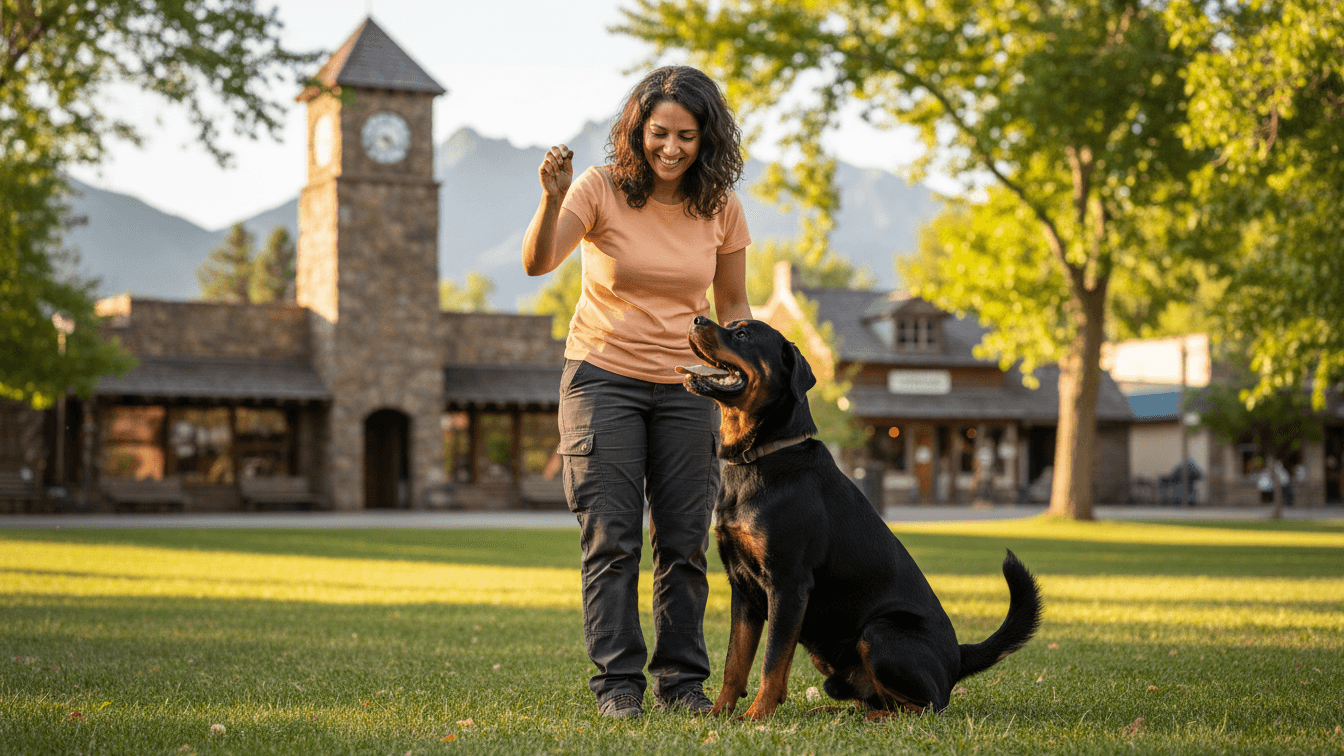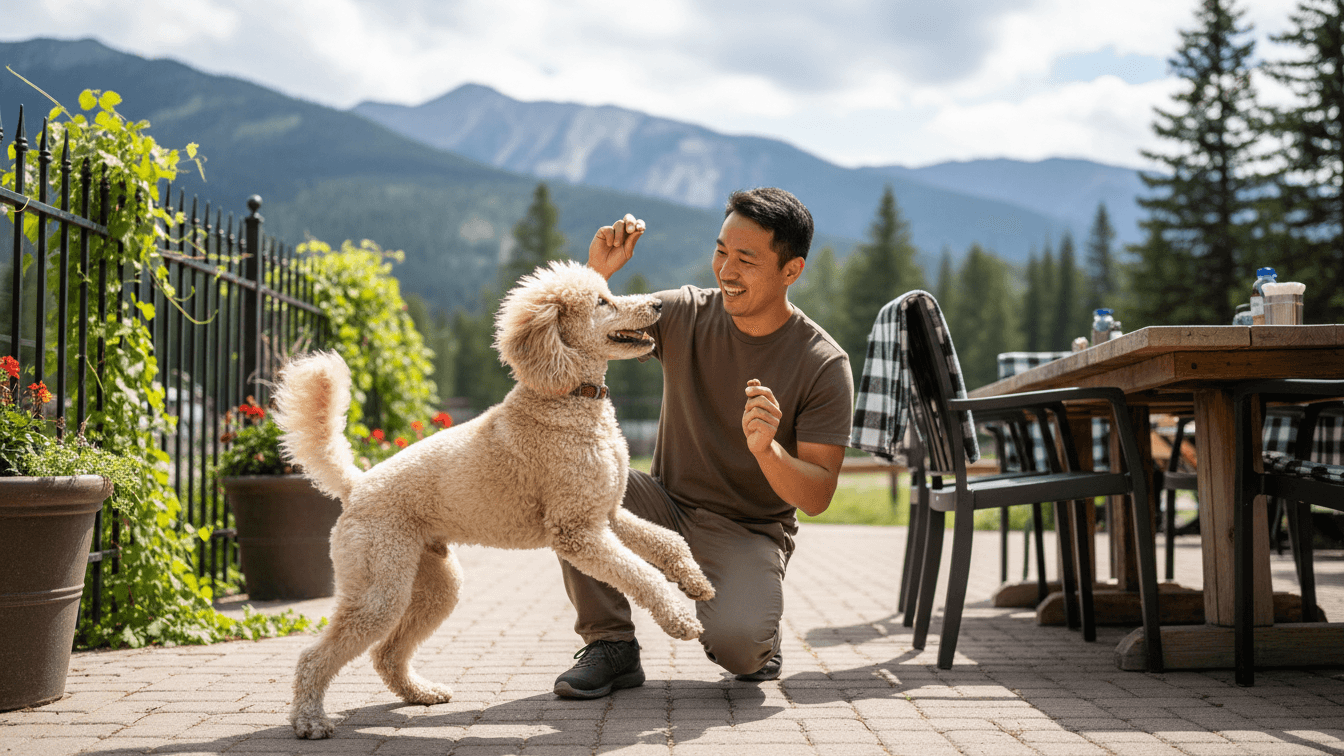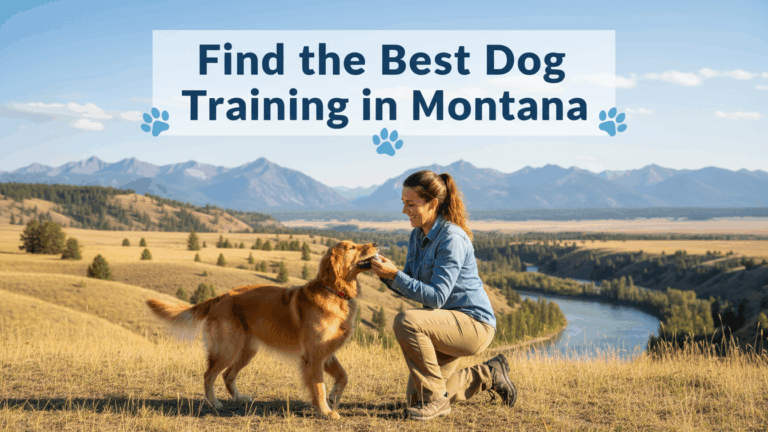Your Complete Guide to Choosing a Dog Trainer in Montana and Surrounding Areas
Living with a dog in Montana means navigating everything from wildlife encounters on hiking trails to off-leash recreation in vast open spaces. Your dog needs to handle encounters with deer, elk, and other dogs on popular trails while staying focused during visits to local pet-friendly businesses.
Montana’s combination of rural areas, small towns, and outdoor recreation creates unique training needs. When you find a trainer who understands these local details, you’ll get better results both at home and out exploring Montana’s public lands.
How to Choose the Right Trainer
Start by looking for someone who uses positive reinforcement training and can set realistic goals for Montana life. This means your dog should learn reliable recalls around wildlife, stay calm near livestock, and handle the independence needed for trail adventures.
Credentials give you a quick way to compare trainers’ experience levels. Common dog trainer certifications include KPA-CTP, CPDT-KA, or IAABC-CDBC for behavior problems. If your dog has serious aggression issues, look for someone with CBCC-KA or a science-based program like CTC.
In-home dog training works great for puppy manners, door greetings, and foundation skills. Group classes make sense once your dog can focus around other dogs, especially before you try busier spots like farmers markets or outdoor festivals.
Common Dog Training Methods Explained

Reward-based methods build the trust you want while creating lasting behavior changes. They also help you follow Montana’s leash laws and keep your dog safe around unpredictable wildlife.
Basic obedience covers sit, down, stay, place, recall, and leash training so your dog can handle trail encounters, brewery patios, and downtown visits without pulling or jumping on people.
Puppy training focuses on socialization, potty training, bite control, crate comfort, and early leash skills. Starting with short, positive training sessions prevents bad habits from forming in the first place.
Behavior modification addresses fear, reactivity, resource guarding, or separation anxiety through careful desensitization and counterconditioning. For serious cases, ask if your trainer works with local veterinarians.
Private lessons let you customize everything around your daily routines, while board and train programs can speed up results when you’re short on time. Make sure any board and train facility gives you detailed handoff sessions so you can maintain the progress.
Group classes help your dog practice good manners around other dogs and people. The best classes give dogs plenty of space, screen participants carefully, and teach calm behavior rather than just excitement.
Specialized training like therapy dog training or service dog training requires extra structure, public-access skills, and a very clear step-by-step training program.
Stay away from trainers who use fear, intimidation, or pain to get results. Humane methods are safer for everyone, easier to maintain long-term, and much better for building the reliable off-leash skills Montana dogs need.
Average Cost of Dog Training in Montana (Updated for 2025)
Prices across Montana depend on the trainer’s experience, how long sessions last, and where the training happens. Rural areas and smaller towns may see slightly lower rates, while trainers in Billings, Missoula, and Bozeman typically charge at the higher end of these ranges.
| Service Type | Average Cost (Montana) |
|---|---|
| Puppy classes (4-6 weeks) | $120-$250 total |
| Group obedience training classes (4-6 weeks) | $140-$280 total |
| Private lessons (60-90 min) | $90-$175 per session |
| In-home coaching packages (4-6 visits) | $380-$850 total |
| Board and train (2-4 weeks) | $1,800-$4,200 total |
| Behavior consult for reactivity/anxiety (initial) | $125-$225 |
You’ll probably pay extra travel fees if you live in more remote areas, and expect higher rates for complex behavior work or specialized training for dogs.
Make sure you understand what’s included, how the trainer tracks progress, and whether they offer a free consultation before you sign up.
Questions to Ask a Potential Dog Trainer
- What training methods do you use, and how do you keep training sessions positive and low-stress?
- What credentials do you have, like KPA-CTP or CPDT-KA? Do you keep up with continuing education such as CPDT-KSA?
- How will you customize the training program for my dog’s specific needs and Montana lifestyle?
- Do you offer in-home visits, dog training classes, or day training, and which approach fits my goals best?
- How will we measure my dog’s progress and know when to add more distractions?
- What are the total costs, including any travel fees, and what’s your cancellation policy?
- Do you carry liability insurance, and can you show me proof?
- For behavior problems, will you work with my veterinarian if needed?
- What should I practice between our sessions to help my dog keep improving?
- Can you help train my dog for Montana-specific situations like wildlife encounters and off-leash reliability?
Local Montana Rules and Considerations for Dog Owners
Montana enforces leash laws differently across counties and municipalities, so check your local ordinances. Most towns require leashes in public parks and downtown areas, while many rural areas and National Forest lands allow off-leash dogs under voice control.
State law requires current rabies vaccination for all dogs over three months old. You can get these through county health departments, veterinary clinics, or mobile vaccination events.
Montana doesn’t require general pet licenses statewide, but many municipalities do. Check with your city or county clerk’s office for local licensing requirements and fees.
Livestock encounters create serious risks for dogs and ranchers alike. Montana law allows ranchers to protect their livestock from threatening dogs, so train a solid recall and keep your dog under control near farms and ranches.
Nuisance barking can be considered disturbing the peace under local ordinances. Work with your professional dog trainer on alert barking and separation anxiety before neighbors start complaining.
Montana doesn’t require special licenses for dog trainers, but if a business boards dogs for payment, they may need to register with local health departments and carry appropriate liability insurance.
Dogs must be under control in Montana state parks, which typically means on-leash unless in designated off-leash areas. You can find specific rules on Montana Fish, Wildlife & Parks website.
Local Montana Resources for Dog Owners and Surrounding Areas
These spots give you great places to practice polite manners, work on recalls, and provide safe enrichment for your dog. Always follow the posted rules and etiquette guidelines.
- Beall Park Dog Park in Bozeman offers fenced areas where dogs can play off-leash and practice socialization with other dogs
- Rose Park in Billings includes a popular off-leash dog area where you can work on recall and calm greetings during quieter morning hours
- Jacobs Island Bark Park in Missoula provides fenced sections for small and large dogs with clear posted rules
- Hyalite Canyon near Bozeman welcomes leashed dogs on most trails, perfect for teaching calm focus around hikers and wildlife
- Mount Helena City Park in Helena offers miles of trails where leashed dogs can practice loose-leash walking and impulse control around deer and other trail users

FAQs
How much does in-home dog training cost?
Most Montana trainers charge $90-$175 per in-home visit, with discounts available when you buy packages. Behavior problems and specialized service dog training typically start at the higher end of that range.
Is in-home dog training worth it?
Absolutely, because you’re working on problems exactly where they happen. Your trainer can fix door manners, jumping on guests, counter-surfing, and yard reactivity right at home, then step outside to practice leash skills on your actual neighborhood streets or trails.
Can you pay someone to house train your dog?
Yes, many trainers offer puppy training programs that include potty training, crate routines, and daily schedules. Day training can speed up the process while teaching you how to maintain the progress.
What is the 3-3-3 rule for dog training?
This is a helpful timeline for new or adopted dogs: expect about 3 days for your dog to decompress, 3 weeks to learn your routines, and 3 months to feel completely settled. Good training programs work with this natural adjustment period.
How long will it take to reach my training goals?
Most puppies and friendly adult dogs show solid progress within 4-8 weeks if you practice daily. Fear, reactivity, or aggression typically requires several months of careful behavior modification with gradual increases in difficulty.
What should I bring to group classes?
Pack a flat collar or harness, a 6-foot leash, high-value treats, water, and current vaccination records if your trainer requests them. Leave retractable leashes at home for safety reasons.
What’s the leash law in Montana?
Leash laws vary by city and county across Montana. Most incorporated towns require leashes in public parks and downtown areas, but many rural areas and National Forest lands allow well-trained dogs under voice control. Check your specific city or county ordinances.
Do I need a dog license in Montana?
Montana doesn’t require statewide dog licenses, but many cities and counties do require local registration. Contact your city or county clerk’s office for specific requirements and fees in your area.
What shots does my dog need in Montana?
Rabies vaccination is required by state law for all dogs over three months old. Your veterinarian may also recommend distemper-parvo combination and bordetella based on your dog’s lifestyle and exposure risks.
Are dog trainers required to be licensed in Montana?
No special trainer licenses exist in Montana. Dog trainers follow normal business regulations, but if they offer board and train services that include overnight stays, they may need to meet local health department requirements.
Where can I practice off-leash recall?
Use fenced dog parks like those in Bozeman, Billings, and Missoula to keep things safe and legal while building skills. Many National Forest areas allow off-leash dogs under voice control, but start in fenced areas until your dog has a bulletproof recall.
Which dog parks allow training around Montana?
Beall Park Dog Park in Bozeman, Rose Park in Billings, and Jacobs Island Bark Park in Missoula all allow off-leash play within their fenced areas. These locations work well for practicing recalls and calm greetings during less crowded times.
What trails allow dogs for training?
Most trails in Montana's National Forests and many state parks welcome leashed dogs. Popular options include Hyalite Canyon near Bozeman, Mount Helena City Park in Helena, and Rattlesnake National Recreation Area near Missoula. These trails are perfect for teaching calm focus around hikers, mountain bikers, and wildlife.
How do I train my dog around wildlife?
Start by building a strong recall in low-distraction environments first. Practice the “leave it” command with increasingly tempting objects before you encounter wildlife. Keep your dog on a long line during training until they can reliably disengage from deer, elk, or other animals on command.
What should I do if my dog chases livestock?
This is both a safety issue and a legal one in Montana. Ranchers have the right to protect their livestock from threatening dogs. Work with a certified dog trainer on impulse control and a rock-solid recall before allowing your dog off-leash near any agricultural areas.
The right combination of thoughtful planning, humane methods, and consistent practice around Montana’s trails and towns will help your dog become a confident, well-behaved dog. If credentials matter to you, don’t hesitate to ask about dog trainer certifications and how your trainer stays current with new techniques.
